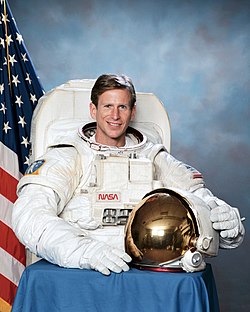- The pale blue Earth serves as a backdrop for astronaut Michael Gernhardt, who is attached to the Space Shuttle Endeavour 's robot arm during a spacewalk on the STS-69 mission in 1995.
- STS104-315-013 (July 12–24, 2001) --- Holding onto the end effector of the Canadarm on the Space Shuttle Atlantis, astronaut Michael L. Gernhardt, STS-104 mission specialist, participates in one of three STS-104 space walks.
- An all-star gathering of legendary American astronauts appeared in Cleveland August 29, 2008 to celebrate NASA's 50th anniversary.
Michael Gernhardt | |
|---|---|
 Gernhardt in July 1995 | |
| Born | Michael Landon Gernhardt May 4, 1956 Mansfield, Ohio, U.S. |
| Education | Vanderbilt University (BS) University of Pennsylvania (MS, PhD) |
| Space career | |
| NASA astronaut | |
Time in space | 43d 7h 1m |
| Selection | NASA Group 14 (1992) |
Total EVAs | 4 |
Total EVA time | 23h, 16m |
| Missions | STS-69 STS-83 STS-94 STS-104 |
Mission insignia | |
Michael Landon Gernhardt (born May 4, 1956) is a retired NASA astronaut, manager of the Environmental Physiology Laboratory, and principal investigator of the Prebreathe Reduction Program (PRP) at the Lyndon B. Johnson Space Center. [1]
Contents
- Early life and education
- Career
- Undersea career
- NASA career
- Spaceflight experience
- Awards and honors
- Personal life
- References
- External links
Gernhardt was selected as an astronaut in March 1992 and flew on four space shuttle missions: STS-69 (1995), STS-83 (1997), STS-94 (1997), and STS-104 (2001). [2] Over his career, he spent more than 43 days in space and completed four spacewalks totaling 23 hours and 16 minutes. [2] He also participated in NASA's first NEEMO mission in an underwater habitat and played a key role in later NEEMO missions that simulated lunar, Martian, and asteroid environments. [2]







